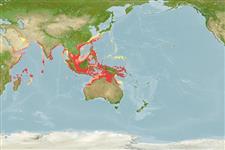Environment: milieu / climate zone / depth range / distribution range
Écologie
marin; saumâtre récifal; amphidrome (Ref. 51243); profondeur 0 - 120 m (Ref. 30573). Tropical; 35°N - 20°S, 40°E - 156°E (Ref. 55462)
Indo-Pacific: probably throughout the warmer coastal waters, from the Red Sea and East Africa to the Solomon Islands, north to southern Japan, south to northern Australia. Recently reported from Tonga (Ref. 53797).
Taille / Poids / Âge
Maturity: Lm ? range ? - ? cm
Max length : 100.0 cm SL mâle / non sexé; (Ref. 188); 36.6 cm SL (female); common length : 60.0 cm TL mâle / non sexé; (Ref. 5450)
Épines dorsales (Total) : 0; Rayons mous dorsaux (Total) : 16 - 19; Épines anales: 0; Rayons mous anaux: 29 - 36. Diagnosis: The slightly shorter pectoral fin, 11-13% of standard length, and the black marking of the upper part of the dorsal fin are the only satisfactory characters separating this species from Chirocentrus nudus; there is also some black on the anterior part of the anal fin (Ref. 188).
Occurs inshore, including brackish waters (Ref. 12743), from the shore to a depth of about 120 m (Ref. 30573). In Australia, it was reported in water temperatures of 26.0-29.0 °C (Ref. 4959). It feeds mainly on small fish and crustaceans (Ref. 188, 30573). Voracious predators of small schooling fishes, e.g. herrings and anchovies (Ref. 37816). Marketed fresh, frozen or dried and salted.
Life cycle and mating behavior
Maturité | Reproduction | Frai | Œufs | Fécondité | Larves
Whitehead, P.J.P., 1985. FAO Species Catalogue. Vol. 7. Clupeoid fishes of the world (suborder Clupeoidei). An annotated and illustrated catalogue of the herrings, sardines, pilchards, sprats, shads, anchovies and wolf-herrings. FAO Fish. Synop. 125(7/1):1-303. Rome: FAO. (Ref. 188)
Statut dans la liste rouge de l'IUCN (Ref. 130435: Version 2024-1)
Menace pour l'homme
Harmless
Utilisations par l'homme
Pêcheries: commercial; pêche sportive: oui; appât: usually
Outils
Articles particuliers
Télécharger en XML
Sources Internet
Estimates based on models
Preferred temperature (Ref.
123201): 25.5 - 29.1, mean 28.1 °C (based on 1980 cells).
Phylogenetic diversity index (Ref.
82804): PD
50 = 1.0000 [Uniqueness, from 0.5 = low to 2.0 = high].
Bayesian length-weight: a=0.00513 (0.00361 - 0.00729), b=2.96 (2.86 - 3.06), in cm total length, based on LWR estimates for this species (Ref.
93245).
Niveau trophique (Ref.
69278): 4.4 ±0.89 se; based on food items.
Résilience (Ref.
120179): Milieu, temps minimum de doublement de population : 1,4 à 4,4 années (Assuming tm=2).
Prior r = 0.54, 95% CL = 0.36 - 0.81, Based on 9 data-limited stock assessments.
Fishing Vulnerability (Ref.
59153): High to very high vulnerability (73 of 100).
Climate Vulnerability (Ref.
125649): High to very high vulnerability (75 of 100).
Nutrients (Ref.
124155): Calcium = 24.9 [13.8, 49.1] mg/100g; Iron = 0.471 [0.261, 0.831] mg/100g; Protein = 20.3 [17.7, 22.5] %; Omega3 = 0.138 [0.072, 0.264] g/100g; Selenium = 51.3 [26.6, 110.1] μg/100g; VitaminA = 67.5 [19.3, 202.7] μg/100g; Zinc = 0.827 [0.566, 1.249] mg/100g (wet weight); based on
nutrient studies.
